The 10 Best Superhero Role-Playing Games
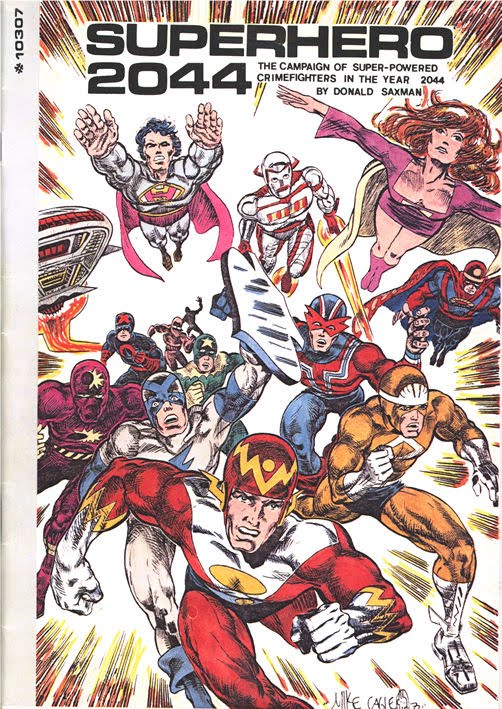 |
| Copyright 1977 Gamescience, Inc. |
The first commercially released role playing game – Dungeons & Dragons – was published in 1974. The game spread like wildfire and the market quickly responded to the phenomenon. What is remarkable about the early days of the role playing game hobby is how creative the initial D&D inspired products were. Unlike in the d20 boom of the early 2000s, the majority of the role playing games released by competitors weren’t derivative books that were mere clones of the initial D&D rules set.
This isn’t to say that no one was releasing competing fantasy role playing games into the market, or that no games would be released using mechanics clearly based on D&D‘s combat system. Those things would happen, but the truly derivative products took some time to reach the market. The early entries into the role playing game marketplace, both by TSR and others, covered a wide variety of genres. D&D was published in 1974; the next year saw the publication of Boot Hill, a Western role playing game published by TSR; En Garde!, a game of swashbuckling Three Musketeers-esque action published by GDW; and Tunnels & Trolls by Flying Buffalo. Of these three games, only one was in the same genre as D&D and it was written as a response to the nigh-unplayability of the original D&D rules. Tunnels & Trolls may have shared some features with D&D, but mechanically and tonally it was clearly a different product. T&T was a product that would revolutionize the role playing game industry in its own way, but that is a story for another time.
Steve Perrin in Different Worlds #23 – an issue dedicated to the rise of superhero role playing games – asserts that Superhero 2044 by Donald Saxman is the first commercially available superhero-themed role playing game. Saxman’s game was self-published in a small print run in 1977 under the name Superhero ’44. When Lou Zocchi’s company Gamescience Inc. published a second edition of the game later that year, the name was changed to Superhero 2044. While the game was more the skeleton of a game than a full game in its own right, it is the fertile soil from which a number of later games grew. Grow they did. In 1977, Superhero 2044 was the only superhero game on the market. By 1984, there were no fewer than six competing games in the genre, one of them a Marvel-based role-playing game published by the industry’s giant, TSR.
Like the white box D&D rules set, Superhero 2044 is nigh unplayable as written. Also like D&D, Superhero 2044 inspired creative minds that led to the creation of a vibrant new gaming market. While the superhero role playing game market has never come close to matching the size of the fantasy RPG market, it has been a robust market that has seen quite almost 100 different games. Many of these games are quite good and so the task of selecting the 10 best superhero role playing games is no easy task; although with games likeThe Foundation, it isn’t impossible.
Before I begin this list, I should warn you that superhero-themed RPGs are my obsession. I have made it my life’s goal to own a copy of every super hero RPG ever published and I’m doing pretty well. If I don’t own it, it’s either really rare, a foreign game, or exists only in digital form. I’m not saying this as an assertion of my authority, or to dismiss your personal favorites. Though if you disagree with me, you are clearly wrong and your favorite game was ignored because it was found wanting which is why I crucified it upon the Tree of Woe. Do you see it? That’s right, it’s the game nailed right next to SPI’s DALLAS role-playing game.
What are the 10 best super hero RPGs, according to this crazed obsessive?
10 – Savage Worlds/Necessary Evil
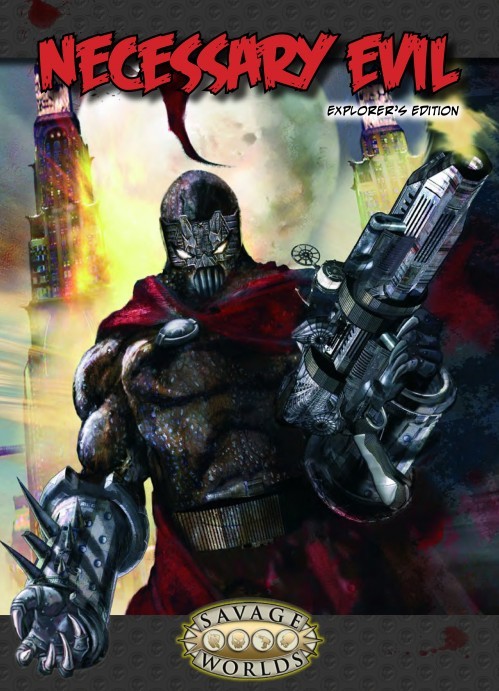 |
| Pinnacle Entertainment Group |
When Pinnacle Entertainment Group released the Savage Worlds game system in 2003, it seemed like everyone else was publishing a d20 based game system and taking advantage of the fact that they could release a game by reprinting someone else’s hard work in a new package. Shane Hensley and crew did exactly the opposite. They created a “Fast, Furious, and Fun” – it even said so on the book – rules set that they claimed could be used for any genre with only a moderate amount of tweaking. Needless to say, I was impressed with the game and its line of fantasy, pirate and monster-hunting products. I also didn’t believe for one second that the rules structure could be used as the basis for a super hero role playing game.
Shane and crew quickly proved me wrong. When the Necessary Evil set came out in 2004, Pinnacle not only released one of the best super hero game systems published to date, but they also published what may be the single best setting for a superhero game to date. Here’s how the good folks at Pinnacle describe it:
The Fate Of The World Lies With The Scum Of The Earth! When the super heroes of the world are blown to kingdom come by an unstoppable army of invading aliens, who will save the day? Evil… The only forces left to take on the alien menace are the crafty and self-serving super-villains!
That’s right. It’s up to Dr. Doom, Magneto and the Joker to save the world. It was supposed to belong to them after all. While the game does have some small balance issues, the campaign setting and the adventure structure are not to be missed.
9) Superworld
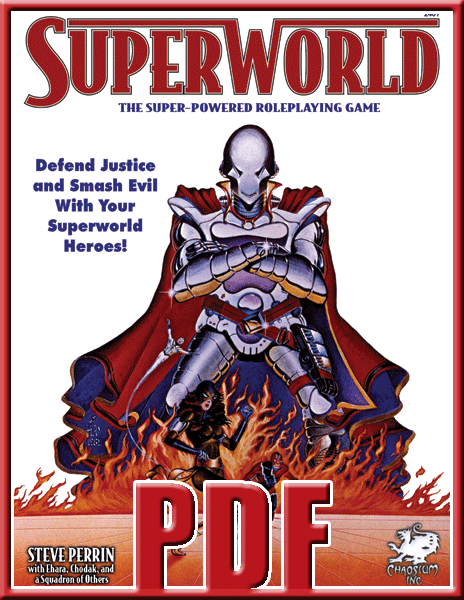 |
| Chaosium |
Are you a fan of the Song of Ice and Fire books (a.k.a. The Game of Thrones)? Are you wondering when the hell George R.R. Martin is going to finish the series, or why it took him so long to write the last entry? Maybe it’s because he’s been playing Superworld with his “writing group” instead of sitting down and doing some actual writing. Improbable? Sure. But impossible? Not at all. You see Superworld is George R.R. Martin’s favorite superhero role-playing game, and it took up a great deal of his writing time in the past. To quote an interview published in Second Person:
“The game was deeply and seriously addictive for all of us…but for me most of all…For more than a year, Superworld consumed me, and during that time I wrote almost nothing. Instead I spent my days coming up with ingenious new plot twists to frustrate and delight my players, and rolling up still more villains to bedevil them.“
That obsession eventually led to the publication of the Wild Cards series of shared world super hero novels, for which many fans are grateful. I don’t actually think that Martin’s pace on his latest series has anything to do with Superworld, but when I feel my fan rage rising I tell myself it does. Superworld started its gaming life as a small booklet in a multi-genre product called Worlds of Wonder published by Chaosium. Worlds of Wonder used a conceit that was kind of like Westworld the RPG, but with Superworld instead of Rome World. Superworld was written by Steve Perrin and is rooted in Chaosium’s in-house “Basic Role Playing” game system, using a point based character building system. It is a good system, but it is greatly improved with the addition of the Superworld Companion. The Companion has contributions by a number of authors including Wayne Shaw. Remember that name: it will be coming up again.
8) Teenage Mutant Ninja Turtles
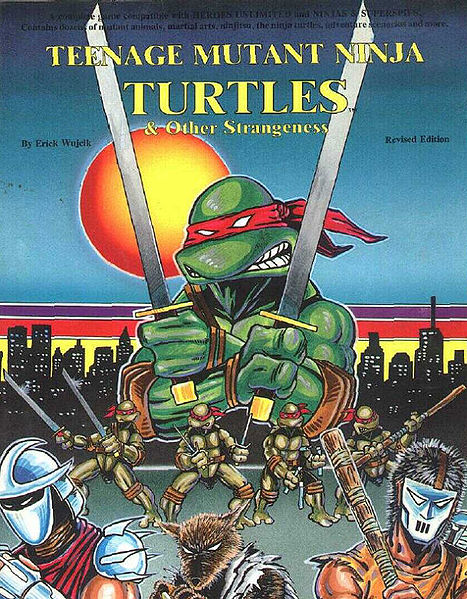 |
| RPG Geek |
It almost sounds like the game design version of Jackass. I can picture the scene even. Kevin Siembieda walks up to Erick Wujcik and says, “Erick. I want you to work on this new product license. It’s an adaptation of Frank Miller’s Daredevil that features mutated pizza loving turtles named after renaissance master painters.” Never mind that the books were entertaining. Think about it from a pure game design stand point. You’ve got the standard licensed product problem, “who gets to be Raphael?” Add to this that when the game was published the TMNT universe wasn’t richly detailed and the fact that Wujcik would be required to use Palladium’s in house game system. Wujcik, who would later go on to write the innovative Amber Diceless Role Playing Game, responded with what is a remarkably strong game.
One of the first things that Wujcik did was to add the possibility of other mutated animals. Now the players could choose to be the turtles, or they could choose to design their own crazy anthropomorphic martial-arts masters. The character creation system by itself is a joy. More surprising is how well the Palladium system, which I normally find to be too time-consuming, fits with the back and forth interplay of martial arts style combat. Wujcik managed to combine what was most interesting about the theme and integrate it with the rules set. That is no small feat.
7) Marvel SAGA
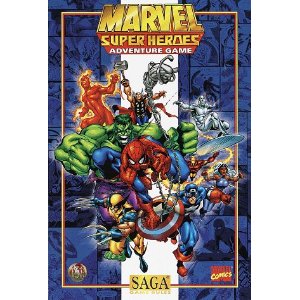 |
| Most Unread Blog Ever |
That’s right, Marvel SAGA. It’s the version of the Marvel RPG that was published during the Lorraine Williams reign at TSR, and it is one of the best role playing games I have ever played…period. Though when I found out that the game was based on TSR’s “new and exciting” SAGA game engine I was less than enthused. TSR had already released a Dragonlance version of the SAGA rules and it was in many ways unplayable. Seriously. It’s impossible for players to ever think about fighting a dragon in the SAGA version of that game. And playing Dragonlance without being able to fight dragons is like playing Kobolds Ate My Baby without any Kobolds…or babies.
When I finally opened up the box and played this game for the first time, I was amazed. Here was a game that finally answered one of the most difficult questions to answer in all of comics, “why do Thor, Iron Man, Hercules, Wonder Man, the Vision, and heaven knows what other epically powerful superheroes even bother to hang out with Captain America?” SAGA‘s answer is quite simple. Those other heroes might have super powers to spare, but Cap has the cream and the clear…I mean…well he has those, but he’s also got “Edge.” The game’s task resolution mechanic takes into account how experienced a character is in a way that allows Cap to keep up and excel without requiring the game to give him superhuman physical strength and agility. Not any more strength and agility that any of us couldn’t acquire through the Super Soldier Steroids, anyway. It was an elegant solution. The game is easy to learn but deep and able to support long term campaign play. There’s a reason this game can go for upwards of $100.
6) Villains and Vigilantes
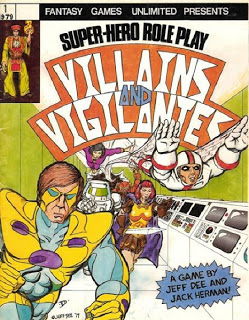 |
| Hero Press |
The first edition of Villains and Vigilantes was the second superhero role playing game ever published. Unlike Superhero 2044, it was playable out of the gate, and it had an interesting conceit in character creation. In V&V, the players were supposed to create alternate versions of themselves. Players would work with the game master to come to consensus regarding how strong or smart the player was and this would be reflected in the initial character statistics. It was an interesting premise, but one can imagine that it led to a lot of arguments. After all, can you imagine your game master asking you to bring a copy of your GRE scores in order to justify your 16 intelligence? Me either. I just challenged my GM to a series of Nim games and push up contests.
Jeff Dee and Jack Herman were quite young when they created the V&V game, and it shows in a couple of areas. The combat system is particularly burdensome. Players were expected to use a chart where they compared the attack they were using to the best five defenses their opponent possessed. Each of these defenses provided a percentage chance of being affected. These probabilities were added together to provide a chance to hit, after which everyone went home because the first round of combat took 2 hours. The second edition streamlined the system and added a number of powers to the game, a streamlining that resulted in a smooth playing and well supported role playing game that is still available today. While the game was originally published by Fantasy Games Unlimited, Dee and Herman have been fighting to get the rights back and are publishing the game through their Monkey House Games company.
5) Smallville
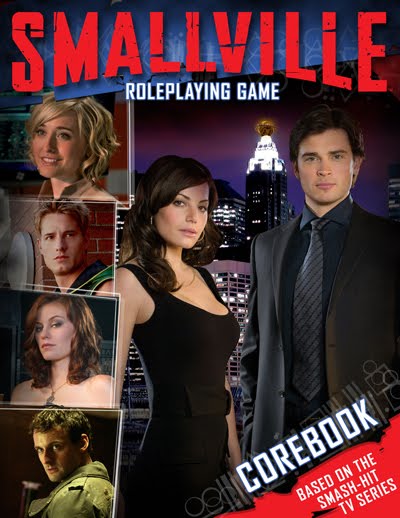 |
| The Empyrean |
When I found out that Margaret Weis Productions had acquired the rights to create a role-playing game based on the Smallville television show, I was excited. The company’s in-house Cortex game system is a versatile narrative role playing system that incorporates mechanics from fast and furious games like Savage Worlds and combines them with mechanics from independent storytelling games. This combination manages to capture both the superheroic combat and soap operatic elements of the Smallville franchise. I would argue that this ability makes the Cortex system the perfect system to represent the comic book action of the classic Byrne/Claremont era of the X-Men, and it seems that others agree. Margaret Weis Productions also used their Cortex system as the foundation for their Origins Award-Winning Marvel Heroic Role Playing Game.
As strong as the Marvel Heroic game is, it doesn’t make this list because I think that Smallville does the job just a little bit better. Where the Marvel game focuses on translating the Civil War comic book mega event into a gameable format, Smallville focuses on giving players the tools to create adventures in their own city. If Smallville had only one thing to offer, and that thing were its campaign/character creation session rules, it would make this list. It is rare that a system comes along in which the players and GM work together to create the characters, relationships, and tensions which will be used to create stories. Even rarer is when that system is a guided process that can be done in a single game session. Smallville‘s campaign/character creation system is a wonder. Find a copy of the game if you can.
4) Supercrew
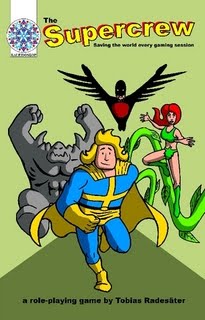 |
| Tobias Rades?ter |
I told you that this list would reflect my own bizarre obsession with superhero role playing games, and this game more than any other reflects my insanity. Tobias Rades?ter’s Supercrew is a purely narrative superhero role playing game that utilizes a number of the common independent role-playing game techniques in its mechanics. The game only requires six-sided dice to play. Each die has a 50% chance of producing a “success,” though some actions require more than one success to succeed. The game allows players to add their character’s “successes” to other player’s actions. All of these are stock and trade of indie RPGs, as is the requirement that players use their least useful power in order to be able to access their best powers.
It is this particular feature, and the fact that the rules are conveyed in comic book form, that makes Supercrew stand out as a gaming experience for me. In most superhero RPGs, the player’s secondary abilities rarely see the light of play. In Supercrew, they have to, otherwise the player won’t be able to use their best abilities. It’s a nice mechanic that helps the game emulate the source material – comic books – in a way many other games don’t. I’ve written at great length about the game in the past. I only wish that the game had more supporting materials. There is some support at the Kaleidoskop website, but it is all in Swedish. Oh…did I mention that the game was Swedish and thus some of the superheroes and villains on the website read like Ikea furniture? Sure, it’s easy to figure out what Gravitationskontroll or Noll Friktion are in English, but I can’t figure out if Osynlighetskappa is a supervillain or a bookshelf.
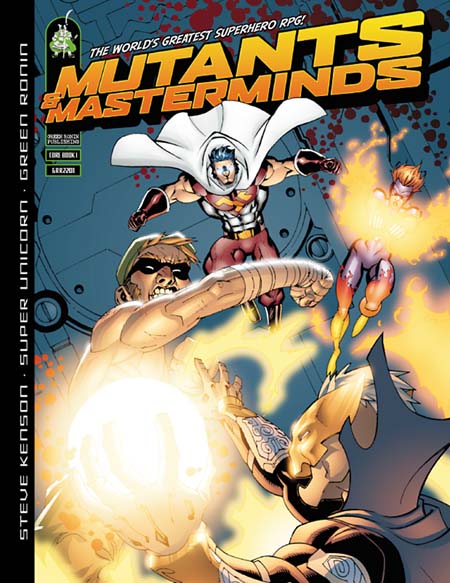 |
| EN World |
As I’ve hinted at a couple of times in this post, the early d20 glut was a period where a lot of mediocre products were published. Many early d20 products were quickly put together, didn’t require a lot of thought, and tried to force the d20 mechanic to work without modification to handle genres it wasn’t designed for. Most of the early d20 attempts at creating a superhero game read more like a cutting and pasting of the D&D Player’s Handbook than like superhero games. After all, how often does Dr. Strange cast Tasha’s Uncontrollable Hideous Laughter or Magic Weapon I? Not very often. Never mind the fact that forcing a Vancian magic system onto comic book action is just plain bizarre.
It is the challenge of making a d20 superhero role-playing game that makes the marvel that is Mutants and Masterminds so impressive. Steve Kenson and crew took the basic mechanic of the d20 system – rolling a twenty-sided die – and built an entire superhero game system around it. The result was nothing short of brilliant. I personally prefer the first edition of the game, when the game was more “power/special effects” focused and before the d20 crowd made them modify the costs of skills because fans couldn’t accept that Batman-type characters had “Super Attributes” that added to all of their skills. That said, all versions of this game are spectacular. The game plays fast, though it does take some time to learn, and isn’t too tactical miniatures wargame in style. You can buy products for the most recent edition of M&M – what is it with RPGs and repeating consonants? – from Green Ronin.
2) Champions
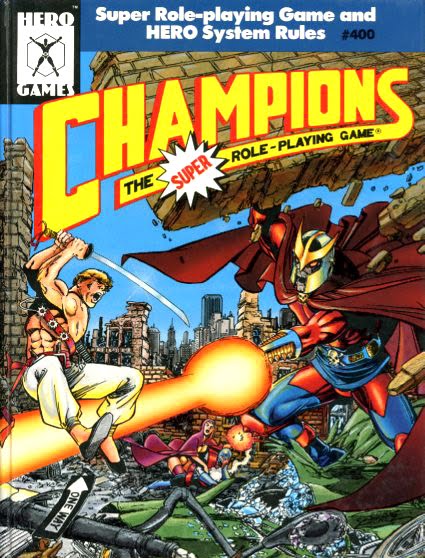 |
| Miks Minis |
When Champions was released at the 1981 Origins Game Convention, it had a revolutionary effect on the game industry. Champions took some of the ideas from Superhero 2044 – point based character creation and some elements of the combat system – and combined them to make the single best tactical superhero game ever made. The point based character creation system was inspired by a modified version of the Superhero 2044 character creation rules. These modified rules were the creation of one Wayne Shaw – remember his name from the Superworld entry? – which were then further modified by the staff at Hero Games to create the most balanced role playing game ever developed. The chief innovation of Champions was its implementation of what is called an “effects based” approach to modeling superpowers. In essence, the player asks what mechanical effect the power has instead of focusing on how the power looks. This was a tremendous innovation that allowed for a power called “Energy Blast” to be used to simulate Dr. Strange’s mystical bolts, Superman’s heat vision and the Human Torch’s blasts of fire. The particular appearance of the power didn’t matter. All that mattered was how much damage the power did and whether the damage was physical, energy or mental.
After two decades of playing Champions, I’ve found that the game is a perfect tactical simulation of comic book action. It’s a kind of Star Fleet Battles with superheroes. But I’ve also found that the heavily mechanical character creation rules have two flaws. First, as inspired as effects-based powers are, the super math geek can manipulate the balance of the game to get extra-competent who push the boundaries of balance. As a small – and not particularly advanced example – players often buy 1 extra inch of movement so that their “half move” is one inch more than normal. Character creation can be heavily mechanical-exploit oriented, which I believe affects the feel of play. Second, it can be intimidating to new players. There are few games that take as long to create a character in as Champions. Only GURPS is more challenging since GURPS requires the same amount of time Champions would take to create Batman to create your average Little League ball player.
For me, the quintessential edition of Champions is its 4th edition. It has the rule book that features George Perez art. The game was balanced and hadn’t begun to collapse under its own library of rules balance tweaks. Steve Long and crew are brilliant game designers an their 5th and 6th editions are very good, but make mine 4th.
1) DC Heroes
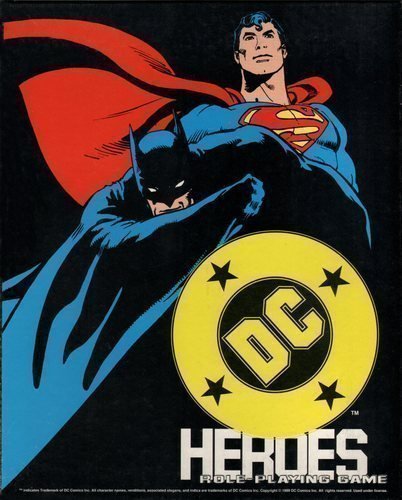 |
What can I say about the DC Heroes role-playing game by Mayfair Games? This is quite simply the best role-playing game ever written. The character creation system is inspired by Champions, but Greg Gorden and his fellow designers managed to eliminate every ounce of tactical war game from the game and created a game where combat and play are “cinematic.” Champions can feel a bit like Car Wars with super heroes and can have 3 hour long combats that last 14 seconds of “game time.” DC Heroes focuses on simulating the fast paced action of comic books. The game mechanics are simple, and inspired by those of Superhero 2044 – and yes, Champions too – except in DC Heroes all action is decided by a single die roll with possible rerolls when a player rolls doubles.
The first edition of the game was written with “Pre-Crisis” characters, and doesn’t quite work. The second edition of the game is a masterpiece and the adventure included in the boxed set “EXPOSED” sets the tone of game play perfectly. EXPOSED is inspired by the Maguire/Giffen era of the Justice League, and as such combines combat with key moments for role playing and humor. As innovative as the DC Heroes game system was/is, it is in the game master advice sections that the game truly shines. The rule books discuss how to incorporate player sub plots into game play, and how players should be allowed to use hero points to affect their environments and advance story. These are elements that are now common in independent narrative games, but they are still fresh when applied to the superhero game. You may prefer Champions to DC, and it is a great game, but I’ve never had players enter into escalating mechanical minutiae wars with my villains in DC.
Honorable Mention –
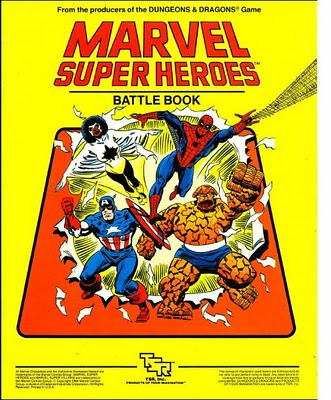 |
I would be remiss if I didn’t mention TSR’s Marvel role playing game that was originally published in 1984. It is a great introductory role playing game. More importantly its core game attributes (Fighting, Agility, Strength, Endurance, Reason, Intuition, and Psyche) create the anagram FASERIP – an anagram they make sure to point out in the game.
How can you not love a system that eventually gets called the Face Rip system?
Related Posts
-
The 7 Most Useless Star Trek Main Characters
Want to feel old? It's been nearly 50 years since Star
-
All Hail Galactus, Devourer of Shelf Space
I would like to report an error on Topless Robot. A
by Rob Bricken
About The Author
Christian Lindke
In between studying for a Ph.D. in Political Science at the University of California, Riverside and being a non-profit Program Director, Christian Lindke spends his time experiencing as much of pop culture as possible and playing role playing games. He hosts the Advanced Dungeons and Parenting Blog and holds an M.B.A. in Marketing.
